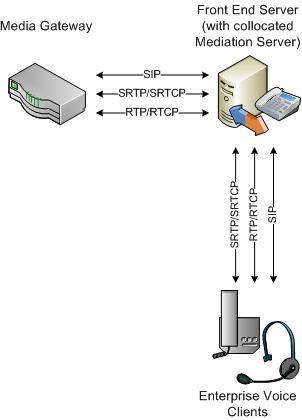Topic Last Modified: 2010-04-12
You must deploy Communications Server 2010 Mediation Server if you choose to deploy the Enterprise Voice workload. In Communications Server 2010, the Mediation Server is collocated with the Front End Server by default. The Mediation Server can also be deployed as a standalone server or separate pool for performance reasons. This topic describes basic functionality, dependencies, basic topologies, and planning guidelines.
Mediation Server translates signaling and, in some configurations, media between your internal Communications Server VoIP infrastructure and an Internet Protocol/Public Switched Telephone Network (IP-PSTN) gateway or a Session Initiation Protocol (SIP) trunk. On the Communications Server side, Mediation Server listens on a single mutual TLS (MTLS) transport address. On the gateway side, Mediation Server listens on a single TCP or TLS transport address. TLS is recommended, but TCP is supported for gateways that do not support TLS.
If you also have an existing Public Branch Exchange (PBX) in your environment, Mediation Server handles calls between Enterprise Voice users and the PBX. If your PBX is an IP-PBX, you can create a direct SIP connection between the PBX and Mediation Server. If your PBX is a Time Division Multiplex (TDM) PBX, you must also deploy an IP-PSTN Gateway between Mediation Server and the PBX.
The main functions of the Mediation Server are as follows:
- Encrypting and decrypting SRTP on the Communications Server
side
- Translating SIP over TCP (for gateways that do not support TLS)
to SIP over mutual TLS
- Translating media streams between Communications Server and the
media gateway
- Connecting clients that are outside the network to internal ICE
components, which enable media traversal of NAT and firewalls
- Acting as an intermediary for call flows that a gateway does
not support, such as calls from remote workers on an Enterprise
Voice client
- In deployments that include SIP trunking, working with the SIP
trunking service provider to provide PSTN support, which eliminates
the need for an IP-PSTN gateway
The following figure shows the signaling and media protocols that are used by the Mediation Server when communicating with a basic media gateway and the Enterprise Voice infrastructure.

 Note: Note: |
|---|
| If you are using TCP or RTP/RTCP (instead of SRTP or SRTCP) on the network between the media gateway and the Mediation Server, it is recommended that this network be a secure private network. |

